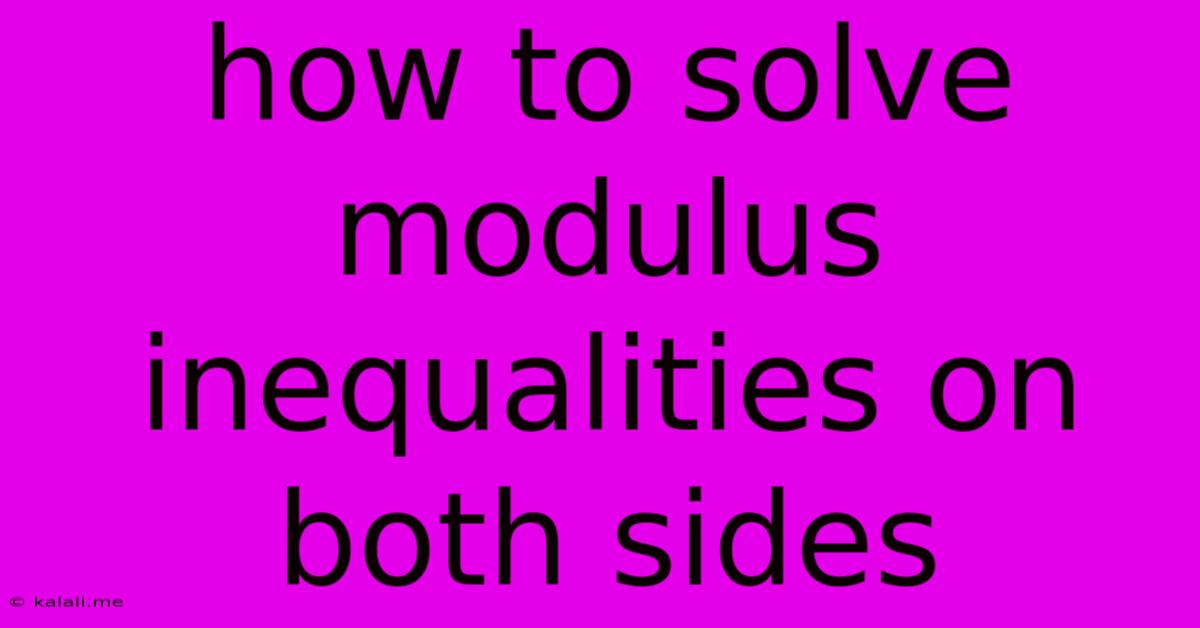How To Solve Modulus Inequalities On Both Sides
Kalali
May 31, 2025 · 3 min read

Table of Contents
How to Solve Modulus Inequalities on Both Sides
Solving modulus inequalities, especially those with modulus expressions on both sides, can seem daunting. However, with a systematic approach and a clear understanding of modulus properties, you can master this technique. This article will guide you through the process, explaining the concepts and providing practical examples. Understanding how to solve these inequalities is crucial for various mathematical applications, including calculus and linear algebra.
Understanding Modulus
The modulus (or absolute value) of a number represents its distance from zero on the number line. Therefore, it's always non-negative. For example, |3| = 3 and |-3| = 3. This understanding is fundamental to solving modulus inequalities.
Solving Modulus Inequalities: A Step-by-Step Guide
When solving inequalities with modulus expressions on both sides, we need to consider different cases depending on the signs of the expressions within the modulus. Here's a general approach:
-
Identify the critical values: These are the values that make the expressions inside the modulus equal to zero. Find these by setting each expression inside the modulus equal to zero and solving for the variable.
-
Create intervals: Based on the critical values, divide the number line into intervals.
-
Analyze each interval: In each interval, determine the signs of the expressions within the modulus. This allows you to remove the modulus signs while preserving the inequality. Remember that:
- If the expression is positive, the modulus remains unchanged.
- If the expression is negative, the modulus becomes the negation of the expression.
-
Solve the resulting inequalities: Solve the inequalities obtained in step 3 for each interval.
-
Combine the solutions: Combine the solutions from all intervals to obtain the final solution set. This might involve union or intersection of the solution sets depending on the original inequality (e.g., less than or equal to vs. greater than).
Example: Solving |x - 2| < |x + 1|
Let's work through a concrete example to illustrate the process. We want to solve the inequality |x - 2| < |x + 1|.
-
Critical values:
- x - 2 = 0 => x = 2
- x + 1 = 0 => x = -1
-
Intervals: The critical values divide the number line into three intervals: (-∞, -1), (-1, 2), and (2, ∞).
-
Analyze each interval:
-
Interval (-∞, -1): Both (x - 2) and (x + 1) are negative. The inequality becomes -(x - 2) < -(x + 1), which simplifies to x - 2 > x + 1. This inequality has no solution.
-
Interval (-1, 2): (x - 2) is negative and (x + 1) is positive. The inequality becomes -(x - 2) < (x + 1), which simplifies to -x + 2 < x + 1. Solving this gives 2x > 1, so x > 1/2.
-
Interval (2, ∞): Both (x - 2) and (x + 1) are positive. The inequality becomes (x - 2) < (x + 1), which simplifies to -2 < 1. This inequality is always true.
-
-
Combine solutions: In the interval (-1, 2), the solution is x > 1/2. In the interval (2, ∞), the inequality is always true. Therefore, the combined solution is x > 1/2.
Conclusion
Solving modulus inequalities with modulus expressions on both sides requires a methodical approach. By carefully considering the critical values, analyzing the intervals, and solving the resulting inequalities, you can effectively tackle these problems. Remember to always check your solutions by substituting values from your solution set back into the original inequality to ensure they satisfy the condition. Practice is key to mastering this important mathematical skill. With enough practice, you'll become proficient in solving even more complex modulus inequalities.
Latest Posts
Latest Posts
-
Why Is The Color Running Out Of My Jeans
Jun 02, 2025
-
To Be Young And In Love
Jun 02, 2025
-
How Do I Make Shelf Smaller
Jun 02, 2025
-
How To Stop Facetime From Lowering Volume Mac
Jun 02, 2025
-
What Is The Change Of Getting Quads
Jun 02, 2025
Related Post
Thank you for visiting our website which covers about How To Solve Modulus Inequalities On Both Sides . We hope the information provided has been useful to you. Feel free to contact us if you have any questions or need further assistance. See you next time and don't miss to bookmark.